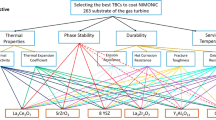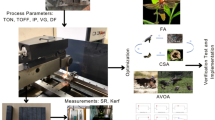Abstract
Modeling the behavior of air plasma spray (APS) process, one of the challenges nowadays is to identify the parameter interdependencies, correlations and individual effects on coating properties, characteristics and influences on the in-service properties. APS modeling requires a global approach which considers the relationships between coating characteristics/ in-service properties and process parameters. Such an approach permits to reduce the development costs. This is why a robust methodology is needed to study these interrelated effects. Artificial intelligence based on fuzzy logic and artificial neural network concepts offers the possibility to develop a global approach to predict the coating characteristics so as to reach the required operating parameters. The model considered coating properties (porosity) and established the relationships with power process parameters (arc current intensity, total plasma gas flow rate, hydrogen content) on the basis of artificial intelligence rules. Consequently, the role and the effects of each power process parameter were discriminated. The specific case of the deposition of alumina–titania (Al2O3–TiO2, 13% by weight) by APS was considered.







Similar content being viewed by others
References
Fauchais P, Montavon G, Vardelle M, Cedelle J (2006) Surf Coat Technol 201:1908–1921
Smith RW, Knight R (1995) JOM 47(8):32–39
Moreau C, Gougeon P, Lamontagne M, Lacasse V, Vaudreuil G, Cielo P (1994) In: Berndt CC, Sampath S (eds) Thermal spray industrial applications. ASM International, Materials Park, pp 431–437
Prystay M, Gougeon P, Moreau C (2001) J Therm Spray Technol 10:67–75
Smith RD, Harlan HU (1976) J Am Ceram Soc 55:979–982
Nelson MM, Illingworth WT (1991) A practical guide to neural networks, 3rd edn. Addison-Wesley, New York
Bhadeshia HKDH (1999) ISIJ Int 39:966–979
Kanta A-F, Montavon G, Planche M-P, Coddet C (2006) Adv Eng Mater 8 (7):628–635
Friis M, Persson C, Wigren J (2001) Surf Coat Technol 141(1–2):115–127
Ogaji SOT, Marinai L, Sampath S, Singh R, Prober SD (2005) Appl Energy 82:81–89
Liang M, Yeap T, Hermansyah A, Rahmati S (2003) Int J Mach Tools Manufact 43:1497–1508
Mamdani EH (1974) Proc IEE 121:1585–1588
Mamdani EH, Assilian S (1975) Int J Man-Machine Studies 7:1–13
Zadeh LA (1973) IEEE Trans Syst Man Cybern 3:28–44
Eker I, Torun Y (2006) Energy Conv Manag 47:377–394
Fraichard T, Garnier P (2001) Robot Auton Syst 34:1–22
Pham DT, **ng L (1995) Neural networks for identification, prediction and control, 2nd printing. Springer, London
Attoh-Okine NO (1999) Adv Eng Softw 30(4):291–302
Bishop CM (1995) Neural Comput 7(1):108–116
Celikoglu HB (2006) Math Comput Model 44:640–658
Kanta A-F, Montavon G, Planche M-P, Coddet C (2007) Adv Eng Mater 9:105–113
Reich Y, Barai SV (1999) Artif Intell Eng 13(3):257–272
Romeo LM, Gareta R (2006) Appl Therm Eng 26:1530–1536
Varacalle DJ, Herman H, Bancke GA, Riggs WL (1992) Surf Coat Technol 54–55:19–24
Fisher IA (1972) Int Met Rev 17:117–129
Steeper TJ, Varacalle DJ, Wilson GC, Riggs WL, Rotolico AJ, Nerz JE (1992) In: Berndt CC (ed) Thermal spray: international advances in coatings technology. ASM International, Materials Park, pp 415–420
Pfender E (1988) Surf Coat Technol 34:1–14
Marsh DR, Weare NE, Walker DL (1961) J Met 2:473–478
Acknowledgements
The French National Agency for Innovation (ANVAR) and the CNRS MRCT “Plasma network” (Réseau Plasma Froid) are gratefully acknowledged for their financial support.
Author information
Authors and Affiliations
Corresponding author
Rights and permissions
About this article
Cite this article
Kanta, AF., Montavon, G., Planche, MP. et al. Artificial Intelligence Computation to Establish Relationships Between APS Process Parameters and Alumina–Titania Coating Properties. Plasma Chem Plasma Process 28, 249–262 (2008). https://doi.org/10.1007/s11090-007-9116-9
Received:
Revised:
Accepted:
Published:
Issue Date:
DOI: https://doi.org/10.1007/s11090-007-9116-9




